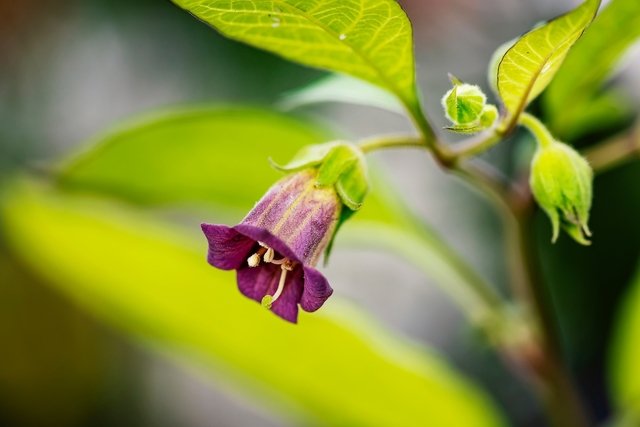Belladonna is an extremely toxic plant that can be used to prepare natural medicines. It can be used to relieve symptoms like gastric cramps from ulcers or period cramps. This plant should only be used by professionals and can be poisonous if used without knowledge at home.
The scientific name of this plant is Atropa belladonna. It is rich in alkaloids, like atropine, scopolamine and hyoscyamine, with antispasmodic, sedative and diuretic properties. These are widely extracted to make medicines, but can cause intoxication and interfere with nervous system function and saliva and sweat production. It can also cause increased pupil size, urinary retention, increased heart rate and blood pressure.
Belladonna can be purchased in some pharmacies and natural health stores and should only be used as directed by a doctor or medicinal plant specialist. It should be stored out of the reach of children, as consuming high doses can be poisonous.

Common uses
Belladonna can be indicated for the following conditions:
- Digestive problems
- Gastric cramps from stomach ulcers
- Intestinal cramps
- Menstrual cramps or dysmenorrhea
- Biliary pain
- Renal colic
- Neurological changes
- Excessive sweating
- Excessive nighttime urination
- Diarrhea with intense cramps
- Irritable bowel syndrome with intestinal spasms
- Stiffness or tremors caused by Parkinson's disease
- Lung collapse due to pneumonia
- Typhoid fever
- Spasms in the bronchi caused by asthma or bronchitis
Belladonna has antispasmodic properties that help to relax the smooth muscles of the intestines, urinary tract, biliary tract, bronchi and uterus. It can also inhibit the production of saliva, sweat, and stomach acid secretions, and additionally has a sedative and diuretic action.
Due to its properties and the natural presence of scopolamine and atropine in its composition, belladonna is widely used for the production of medications, ophthalmological drops to dilate the pupils before exams and homeopathic ointments for rheumatism or muscle pain.
Belladonna should only be used as directed by a doctor or medicinal plant specialist, as it can cause poisoning and be life-threatening.
How to take
Belladonna can be used in the form of a tincture, powder or extract. However, as it is an extremely toxic plant, doses must be administered individually, by a doctor or medicinal plant specialist.
Side effects
Side effects of belladonna include hallucinations, delirium, psychosis, restlessness, agitation, nausea, rapid heartbeat, blurred vision, blindness, gastrointestinal disturbances, headache, and difficulty or inability to urinate.
Furthermore, if consumed in excess, this plant can cause poisoning, heart failure, respiratory arrest, convulsions, coma and death. Therefore, medications that are made with this plant should be used with great care and only under the guidance of a doctor.
Contraindications for use
Belladonna is extremely poisonous, and none of its parts should be used in preparing home remedies. You should avoid direct contact with this plant as there is a risk of it being absorbed through the skin and causing poisoning.
Furthermore, you should not consume its fruits, also referred to as nightshades berries, as they can cause serious poisoning. They are very similar to blueberries and can be consumed by mistake, especially by children, and cause poisoning.
Medications made with this plant should not be used by people with a history of a rapid heartbeat, heart failure, thyrotoxicosis, angle-closure glaucoma, acute pulmonary edema, bladder or bowel obstruction, intestinal paralysis, severe ulcerative colitis, toxic megacolon, myasthenia gravis , acute hemorrhage, hiatal hernia, reflux esophagitis, severe liver and kidney disease, or prostate hyperplasia in men.
Furthermore, belladonna should never be used by children, nor pregnant or breastfeeding women.
